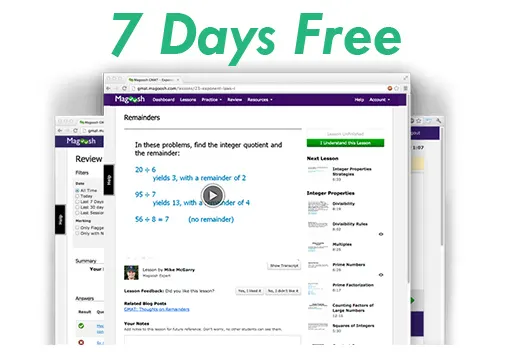If x is positive, is x > 3 ?
(1) (x - 1)^2 > 4
(2) (x - 2)^2 > 9
Statement (1) ALONE is sufficient, but statement (2) alone is not sufficient.
Statement (2) ALONE is sufficient, but statement (1) alone is not sufficient.
BOTH statements TOGETHER are sufficient, but NEITHER statement ALONE is sufficient.
EACH statement ALONE is sufficient.
Statements (1) and (2) TOGETHER are NOT sufficient.
Answer is D...what is the process for answering this?
GMAT Prep Practice Test Quant #6
This topic has expert replies
- MartyMurray
- Legendary Member
- Posts: 2131
- Joined: Mon Feb 03, 2014 9:26 am
- Location: https://martymurraycoaching.com/
- Thanked: 955 times
- Followed by:140 members
- GMAT Score:800
Question: Is x > 3?
Information given: x is positive.
Statement (1): (x - 1)² > 4
In order for the square of a number to be greater than 4, that number has to be greater than 2 or less than -2.
So, in order for (x - 1)² > 4, it must be the case that (x - 1) > 2 or (x - 1) < -2.
Since we are told that x is positive, there is no way in which (x - 1) < -2, because there is no positive x such that (x - 1) < -2.
So, the only way in which (x - 1)² > 4, is (x - 1) > 2.
We can add 1 to both sides of the inequality and get x > 3.
Sufficient.
Statement (2): (x - 2)² > 9
In order for the square of a number to be greater than 9, that number has to be greater than 3 or less than -3.
So, in order for (x - 2)² > 9, it must be the case that (x - 2) > 3 or (x - 2) < -3.
Since we are told that x is positive, there is no way in which (x - 2) < -3, because there is no positive x such that (x - 2) < -3.
So, the only way in which (x - 2)² > 9, is (x - 2) > 3.
We can add 2 to both sides of the inequality and get x > 5.
Sufficient.
The correct answer is D.
Information given: x is positive.
Statement (1): (x - 1)² > 4
In order for the square of a number to be greater than 4, that number has to be greater than 2 or less than -2.
So, in order for (x - 1)² > 4, it must be the case that (x - 1) > 2 or (x - 1) < -2.
Since we are told that x is positive, there is no way in which (x - 1) < -2, because there is no positive x such that (x - 1) < -2.
So, the only way in which (x - 1)² > 4, is (x - 1) > 2.
We can add 1 to both sides of the inequality and get x > 3.
Sufficient.
Statement (2): (x - 2)² > 9
In order for the square of a number to be greater than 9, that number has to be greater than 3 or less than -3.
So, in order for (x - 2)² > 9, it must be the case that (x - 2) > 3 or (x - 2) < -3.
Since we are told that x is positive, there is no way in which (x - 2) < -3, because there is no positive x such that (x - 2) < -3.
So, the only way in which (x - 2)² > 9, is (x - 2) > 3.
We can add 2 to both sides of the inequality and get x > 5.
Sufficient.
The correct answer is D.
Marty Murray
Perfect Scoring Tutor With Over a Decade of Experience
MartyMurrayCoaching.com
Contact me at [email protected] for a free consultation.
Perfect Scoring Tutor With Over a Decade of Experience
MartyMurrayCoaching.com
Contact me at [email protected] for a free consultation.



















